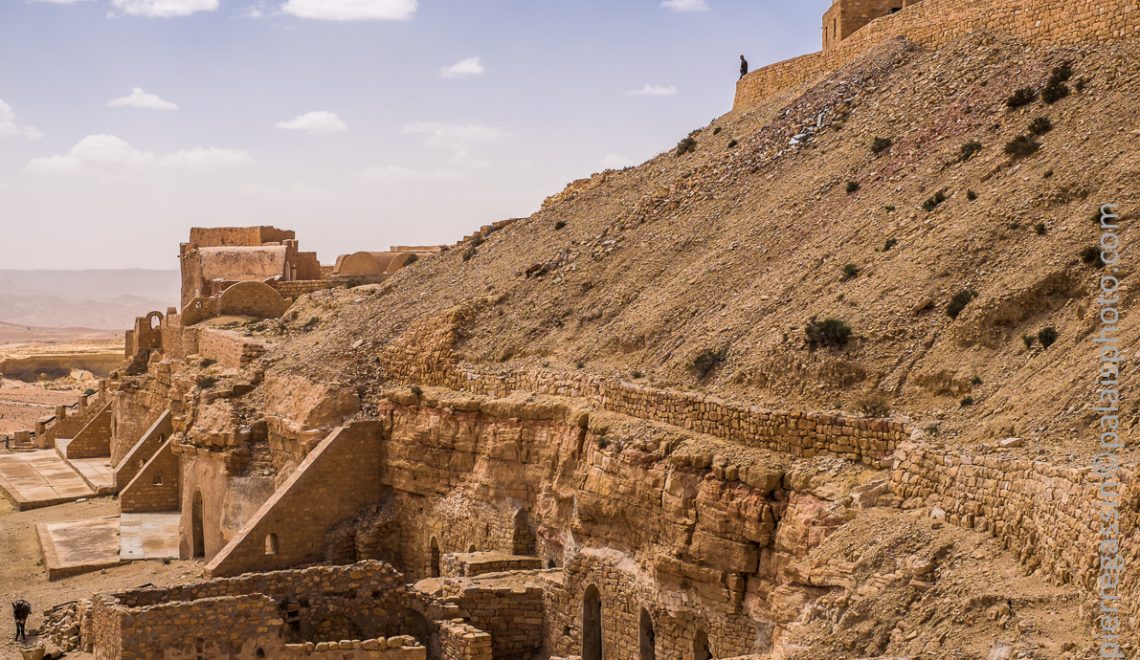
Jebel Dahar is the mountainous massif of south-eastern Tunisia located between the island of Djerba and the Grand Erg Oriental which extends to the Sahara. 2000 years that this land is one of the most important points of passage, those of the caravaneers to the desert, and also a gateway to the East in history and that of passionate discoverers and lovers of confidential journeys these days . Originally Berber-Amazigh, the Dahar offers a natural and cultural heritage that fascinates lovers of discovery wishing to meet and interact with locals, or simply seeking rest. Dahar is an authentic land, a journey that marks a life!
Destination Dahar: In the footsteps of millennial civilizations
Discover Dahar is the promise of encounters and discoveries hidden treasures of the citadel villages attached to the rocky spurs, whose memory is lost in time. True guardians of the old trade routes, the impressive villages of “Guermessa”, “Chénini”, “Douiret” or “Toujène”, sometimes still inhabited, have managed to resist time. They have left us the story of ingenious people who harmoniously tamed an austere nature, melting into the land of Dahar with patience and determination.
The life of the villages was organized around the water, its collection and its preservation in the “Jessours” which allowed thanks to a very elaborate social organization the cultivation of small palm groves and the olive tree. Visit underground olive oil mills or mosques built underground, to meet its inhabitants who will explain their way of life and share moments of their daily lives.
The traditional troglodyte houses, true caves dug on the ground or on the flanks of the Dahar mountains, have been enthusiastically restored by their owners. Refurbished in guest houses and rural cottages, they are designed to offer a warm welcome closer to local traditions. These caves are always pleasant weather to protect themselves from the summer heat as much as the freshness of winter nights. Here, a restorative break after a day of hiking can evolve into a stay of a few days.
The magic of ksours : Nefta, Matmata, Guermessa, Chenini…







Major curiosity, the “ksours” are fortified granaries where the nomadic and semi-nomadic Berber populations stored their property safe from raids and invaders from Roman times. The oldest “ksours”, aligned at the top of the mountains, formed a fortified line. They later multiplied in the plains of the region to serve as warehouses of up to five floors in the middle of which were set up market places. Properties of the families of Dahar, they were built by the tribes, vaulted with limestone covered with clay and adorned with traditional patterns that you can admire.
Dahar, a land of hikes






Walking is the best way to discover the region and enjoy the unique views. It is also the way to be closer to the inhabitants of Dahar, its shepherds and mountaineers who will tell you the paths of their ancestors. From “Béni-Khadeche” trails to “Toujène” or “Matmata” peaks, you will be able to choose variable itineraries, adapted to your desires. Hiking programs vary from half a day to ten days. The trails are also accessible on mountain bikes. The discovery of the region is ideally between the months of October and May and with or without a guide. Considering multi-legged circuits throughout the mountains is just as possible as radiating from the accommodation of your choice.
On the path of dinosaures





Formed about 250 million years ago, the Dahar is a geological treasure that reveals the formation of continents with the separation of the single continent, Pangea, between the African continent, Gonwana, and the European plate, Eurasia.
Site of global interest for geologists around the world, Dahar reveals according to Wikipédia the secrets of the formation of the Earth through visible and decipherable geological layers thanks to available documentation. Its well-preserved geological structure makes it an open-air paleontological museum.
Recent discoveries of one of the largest and oldest crocodiles, 155 million years old, and the skeleton of an entire herbivorous dinosaur with hollow bones more than fifteen meters long dating back to about 110 million years, the “Tataouinea Hannibalis” attracted many scientists to the region.
After a visit to the Museum of the Memory of the Earth Tataouine and a little effort following a good guide, you can put your feet on the fossilized traces of a dinosaur that once populated the Dahar!
Photo Credit : Pierre Gassin


 َAbonnez-vous
َAbonnez-vous

